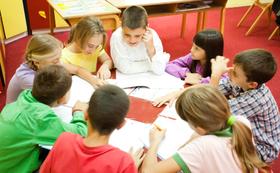Childhood experiences shape who we become as adults, for good and bad. The new Surgeon General of California is pushing for childhood trauma screening in students in the hopes of resolving some of the issues that might later lead to the development of physical and mental health problems.
The new Surgeon General of California is working to implement an unprecedented plan to implement universal screenings for childhood trauma in children benefiting from the state’s Medicaid program.
Dr. Nadine Burke Harris, the first person to hold the newly developed role of Surgeon General of California, is a pediatrician known for studying the harmful effects of adverse childhood experiences and toxic stress. The goal of the program is to identify children living with untreated childhood trauma so they can get the help they need and prevent harmful health effects from developing later in life.
Though Harris has already taken several steps toward implementing this plan, there are those who question its cost. Read on to learn more about the program and to explore the subject of childhood trauma in greater depth.
What Constitutes Childhood Trauma?
According to the American Psychological Association (APA), a traumatic event is one that threatens injury, death, or the physical integrity of self or others and also causes horror, terror, or helplessness at the time it occurs. Examples may include sexual abuse, physical abuse, school or community violence, domestic violence, accidents, medical trauma, national or manmade disasters, and traumatic loss.
The results of a national survey on childhood experiences conducted by the National Survey of Children’s Health (NSCH) suggest that nearly half the nation’s children have experienced at least one type of serious childhood trauma. More concerning than that, however, is the statistic that nearly one-third of U.S. adolescents aged 12 to 17 have experienced two or more types of trauma that are likely to have an effect on their physical or mental health in adulthood. Percentages vary across the different U.S. states from 23% in New Jersey to over 44% in Arizona.
Dr. Christina Bethell, director of the National Maternal and Child Health Data Resource Center, suggests that unless more prevention and trauma-healing programs are provided for these children, many of the nation’s children will go on to suffer chronic disease and mental illness.
Another study conducted by the CDC called the Adverse Childhood Experiences Study (ACE Study) shows a direct link between childhood trauma and the adult onset of chronic disease, violence, mental illness, and being the victim of violence. The study measured ten different types of childhood adversity including the following:
- Physical, sexual, and verbal abuse
- Physical and emotional neglect
- Parent addicted to drugs or alcohol
- Parent diagnosed with mental illness
- Witnessing a mother experiencing abuse
- Losing a parent to abandonment or divorce
- Having a family member in jail
The results of the study were staggering. Nearly 48% of children (newborns to 17 years old) were reported to have at least one of these and about one-fifth (22.6%) had two or more. Considering that any bias in the survey would be in the direction of under-reporting, these results are significant.
Though it is obvious that childhood trauma is a serious and common issue, it can still be somewhat difficult to identify. Children of different ages display signs of traumatic stress differently.
Here is an overview of how children of different ages may react to trauma:
- Preschool Age – Fear of separation from parent/caregiver, crying or screaming a lot, eating poorly, losing weight, having nightmares.
- Elementary School Age – Becoming anxious or fearful, feeling guilt or shame, having difficulty concentrating, having a hard time sleeping.
- Middle and High School – Feeling depressed or alone, developing eating disorders or self-harming behavior, beginning alcohol or drug abuse, exhibiting risky sexual behavior.
Left untreated, these symptoms can progress and have a significant impact on the child’s life, both in childhood and later in adulthood. Research shows that child trauma survivors may go on to develop learning problems and have a higher risk for suspensions and expulsions. They often exhibit increased use of health and mental health services, and often develop long-term health problems like diabetes and heart disease. They also have increased involvement in child welfare and juvenile justice systems.
What is Currently Being Done About It?
There is a wealth of information about post-traumatic stress disorder and the adverse effects of traumatic experiences in adults, but it has become abundantly clear that everything we’ve learned may not necessarily be applicable to children and adolescents. In fact, the field of child and adolescent PTSD and trauma is still very young, though it has been gaining knowledge at a rapid pace.
In 2008, a Presidential Task Force on PTSD in Children and Adolescents was formed to help increase awareness of the issue and to facilitate diagnosis, treatment, and research in the field. Children and adolescents experience stressful and traumatic effects just like adults, and it can affect them both physically and emotionally for years to come. It is the role of parents, caregivers, and family members to be aware of the potential for these harmful effects following a traumatic experience and to respond quickly to any developing symptoms.
Harris’ push for universal screenings for childhood trauma in children is one of the latest steps toward solving this issue. It has gained a great deal of support, but there are always concerns about the cost of such a large program. Read on to learn more about it.
Harris’ Plan for Universal Screening
Dr. Nadine Burke Harris is the first to step into the new role of Surgeon General of California and she is pushing for universal trauma screening of school children. As lofty as this plan is, it has already become more than just a dream. In June, a $45 million budget for trauma screenings was approved by Gov. Gavin Newsom and another $50 million was set aside to cover training for those who will be administering the screenings.
These costs are just a fraction of what the program might cost when fully implemented, so it should come as no surprise that there are critics who question the cost. Experts in the field suggest, however, that early screening could actually save millions of tax dollars each year and that premature deaths and disease could be prevented. The program would also help turn schools into happier and healthier places for both students and teachers.
Here are some of the reasonings behind the universal screening program:
- Untreated childhood trauma can cause permanent biological damage
- Early detection can help resolve the impacts of childhood trauma
- Screenings will help educators better understand their students
Now, let’s delve a little deeper into each of these three statements.
1. Untreated childhood trauma can cause permanent biological damage
The results of the ACE Study confirmed what many child development experts have long suspected to be true – that the impacts of childhood trauma are not necessarily temporary. Experiencing trauma can fundamentally change the child’s brain development as well as various aspects of physical development.
For example, some children who experience childhood trauma experience a change in the way their brain and body respond to future stress. These changes primarily affect the prefrontal cortex, the part of the brain that regulates emotions. A potential consequence is that the child may not be able to understand their own or others’ emotions which can lead to a disconnect between peers and the development of problem behaviors in school.
2. Early detection can help resolve the impacts of childhood trauma
Traumatic experiences cannot be undone, but the impacts can be resolved with early detection and prompt treatment. Adults often underestimate how resilient children can be, so detecting adverse experiences early and seeking help from a trained professional can help the child resolve any lingering effects before they turn into much larger problems. Treatment should also focus on supporting habits that strengthen the child’s resilience such as getting adequate sleep, regular exercise, mindfulness practices, and supporting a nurturing community.
3. Screenings will help educators better understand their students
School-age children are bound to exhibit problem behaviors from time to time, but helping educators understand the reasoning behind those behaviors can help them deal with it in a way that benefits the child. When a child becomes violent, stubborn, or erratic, knowing the child’s history can help the teacher respond in a less punitive way that actually addresses the root cause of the behavior.
Another way to think of it is that teachers will waste less time reacting to things that have already happened and will spend more time proactively addressing larger potential problems. For example, if a teacher is aware that a child has been exposed to trauma, he might ask the school nurse to regularly check the child for developing symptoms of traumatic stress.
The details involved in implementing universal trauma screenings across the nation are myriad and the cost would be high, not to mention the logistical planning involved. It’s not just about performing the screenings, either – it’s also about schools having a plan for what to do with the results. Most experts agree, however, that the benefits outweigh the costs of such a program, and it could actually be a way to address an urgent public health crisis.
What Kind of Trauma Screening Currently Exists?
Whether or not Harris’ plans for universal screening moves forward into the implementation stage, programs already exist to help screen children at-risk for PTSD. The National Child Traumatic Stress Network (NCTSN) offers tools and resources to providers who are dealing with children and families who have experienced a traumatic event. The NCTSN offers in-depth information about trauma screening and tips for implementing a trauma-informed mental health assessment to guide treatment.
According to the NTCSN, trauma screening is “designed to be able to be administered to every child within a given system (such as child welfare) to determine whether he or she has experienced trauma, displays symptoms related to trauma exposure, and/or should be referred for comprehensive trauma-informed mental health assessment.”
The actual trauma screening may be a formalized process or may simply involve the use of certain tools to gather information. It is designed to evaluate the presence of the following:
- Exposure to a potentially traumatic event or experience, including traumatic loss
- Traumatic stress symptoms and/or reactions
The NTCSN recognizes that not all children who experience negative events suffer from trauma-related symptoms and the screening is designed to measure a wide range of experiences. The goal is to identify common reactions and symptoms of trauma to alert providers to the need for a more focused screening and the potential for treatment.
The screening covers the following most common types of traumatic stress reactions:
- Intrusive memories or nightmares of the event
- Avoidance of trauma-related thoughts or feelings
- Hyper-arousal or exaggerated startle response
- Irritable and/or aggressive behavior
- Behavioral or interpersonal problems
Throughout the screening process, the child’s family should be involved and informed. After the screening has been completed, the provider may offer a recommendation that the child see a therapist specializing in treating children with trauma issues. The provider may also recommend a more thorough assessment called a trauma-informed mental health assessment.
How Do Providers Use the Information?
A trauma-informed mental health assessment creates a structured framework for assessment so the information gathered can be communicated clearly to families and providers. The assessment offers a framework for the following:
- Gathering information across several important domains of functioning
- Identifying and addressing the needs of children (and families) exposed to trauma
- Coding and summarizing the information so it can be communicated
The information gathered in the assessment can be used to guide therapy sessions with children or families, helping to develop a treatment goal and detailed treatment plan. The actual assessment may vary from one situation to another and there are several examples of tools and detailed processes that can be used for trauma-informed mental health assessment:
- Child and Adolescent Needs and Strengths (CANS) – A multi-purpose tool that can be utilized in different ways depending on the needs of the particular child-serving system. It is used to gather information on a range of domains relevant to the caregiving system and to incorporate that information directly into individualized care plans.
- Assessment-Based Treatment for Traumatized Children – Developed by the Chadwick Center for Children and Families, the Trauma Assessment Pathway (TAP) was designed for children aged 0 to 18 who have experienced any kind of trauma. These children may or may not be in the welfare system and the process enables clinicians to screen clients and gain an in-depth understanding of the child’s development level, traumatic experience, and support systems.
- Transactional Model – Proposed in 1994 by Spaccarelli, this is an interactive model for understanding the effects of child abuse on the development of symptoms. It examines factors related to abuse as well as the associated investigation, also incorporating factors such as age, sex, personality, social support, previous coping styles, and cognitive appraisal methods.
As you can see, trauma-informed mental health assessment can be modified for a variety of systems and catered to the individual client as needed. Equipped with newfound information from such a comprehensive assessment, providers can make specific recommendations to parents and families of children who could benefit from treatment. It remains the parent’s responsibility, however, to ensure that children get the services they need.
What Should You Do as a Parent?
Though screenings for childhood trauma and treatment programs do exist, they are often limited to certain populations, such as children in the welfare program. Harris suggests that all school-age children be screened for childhood trauma and other experts in the field such as Dr. Christina Bethell agree.
Whether or not a universal program for childhood trauma screenings move forward, it remains the responsibility of parents, families, and caregivers to be cognizant of changes in behavior among school-age children and on the lookout for the development of PTSD symptoms in the wake of a traumatic event. Left unresolved, stress reactions and PTSD symptoms have the potential to negatively impact the child for the rest of his or her life.
As a parent or caregiver of a child who has experienced a traumatic event, take the next step in having your child screened or speak to your provider for a referral to a qualified therapist. The sooner you take action, the sooner your child will receive the help he needs and can start taking steps on the path toward recovery while also preventing future physical and mental health issues.















